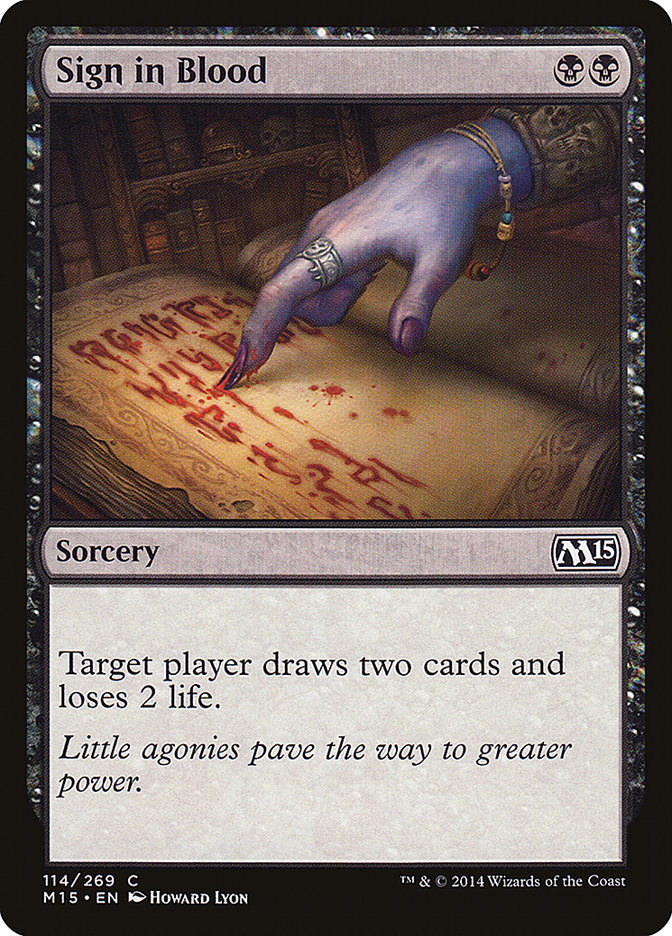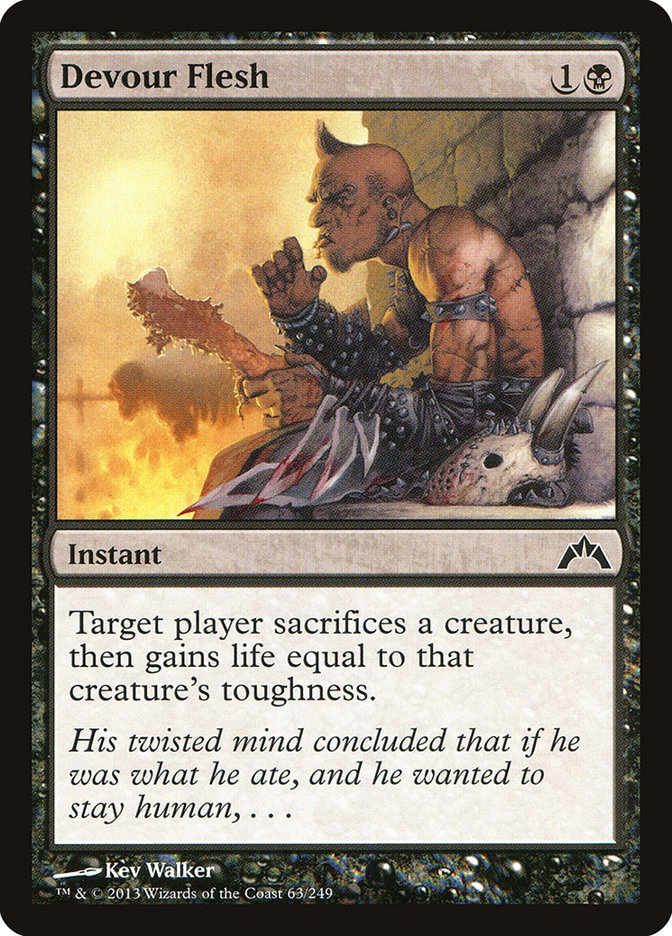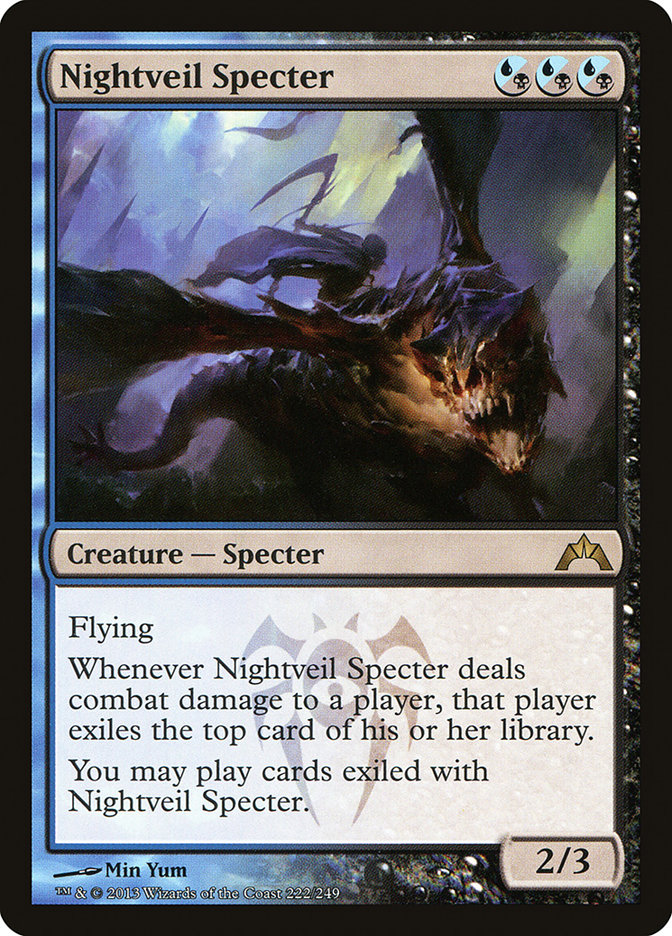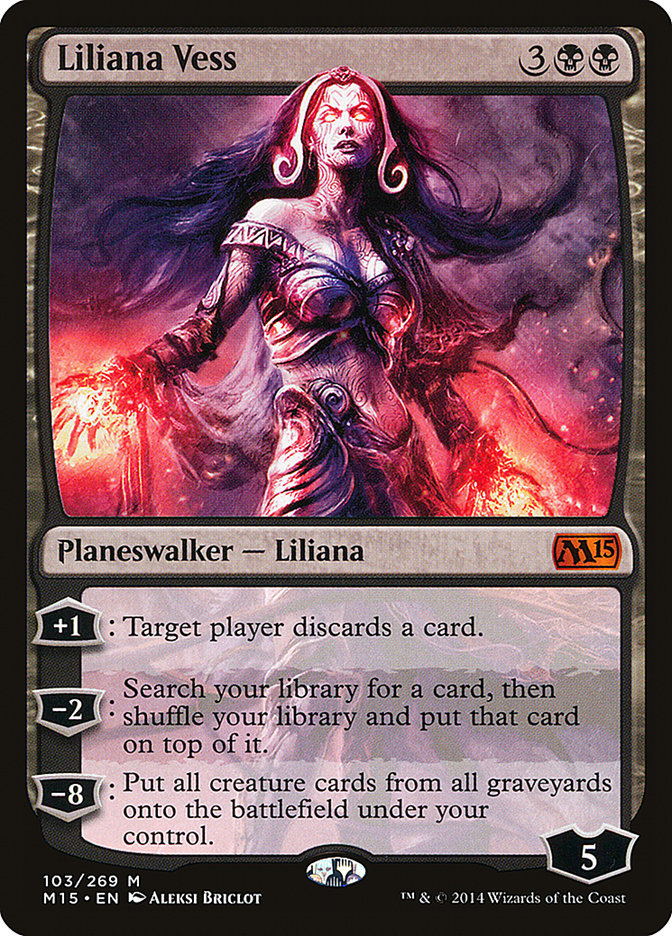The day is finally upon us. The ever climactic Friday when Wizard’s newest expansion shakes up the stale Standard metagame. Magic 2015 introduces 269 cards
pumping life and vitality into a format stricken by archetypes that won’t budge and stagnant outcomes. Finally, a set that’s plump full of game changers
that will forever change the way we see Standard. Once again we are unacquainted with the metagame and must use our superior intellect and creativity to
uncover the greatness that awaits us. Excitement is in the air as we embark into the mysteries that wait to unfold during the first weekend of M15
Standard! The only question is where do we sign up?
So what? You are saying the best card in M15 so happens to go in the already existing best deck in the format? We can “look no further” because you really
won’t be able to do any better than simply continue to play Mono-Black Devotion? That the archetype finally has everything it could ever need to dominate
Standard until the warlords of Tarkir push out the oppressive Return to Ravnica? You know what? I will sign up for that! Let me just get the scalpel and
make this official!
Sign in Blood is the closest you can get to an unprintable Magic card in my personal opinion. Life is far and away the weakest of all the resources in
Magic and one life for one card effects have historically been ban-worthy. This one is less broken due to the one time effect, but how is it okay to be up
a card before an opponent even has a second land in play? This begs the question of “why was this included in M15?” I honestly believe that Wizards might
not know how potentially dominating this card can be in a format that caters to it.
The reason this card was never an oppressive force in the past was simply that the other decks were just too good. Either the card was too slow to keep up
with decks filled with Goblin Guides and Lightning Bolts or not powerful enough to keep up with the oppressive nature of CawBlade. Oh, and the simple truth
that mono-colored decks were just not a thing unless you were hyper aggressive. How the times have changed…
The truth of the matter is I absolutely love the card Sign in Blood. I almost played B/g Control exclusively once M14 came out last summer due to just how
powerful the card was. The list of why this is a tournament staple goes on and on, but never have I seen it in a format already dominated by Swamp-filled
decklists. This summer is going to be an interesting one due to just how super-charged Mono Black Devotion is going to get because of the existence of this
card.
Now there are some rules that come with playing a card like Sign in Blood. The first and more important rule is that you do not play the card if you also
want to splash an additional color. Many Black Devotion decks have been splashing a secondary color to help solve problems that the Mono Black versions
have trouble solving. The cost of having these specific spells can be high due to having so many lands that come into play tapped as well as those that
deal damage when used efficiently. These manabases come with a steep cost that is only magnified with the inclusion of Sign in Blood.
Now while the splash variants have more powerful spells, the Mono Black variants have a pristine manabase that can easily afford a card like Sign in Blood.
In fact, the addition of Sign in Blood allows the deck to care even less about card selection. So much so that the deck no longer needs to bother with
those pesky Temples! It even lets the deck trim on a land!
You see, Sign in Blood does some interesting things for a deck. For starters, it allows the deck to lower the curve significantly while also allowing it to
trim on a land or two. The reason you do this is to be able to cast Sign in Blood early in a game while also being able to “double spell” more often in the
early game to make up for the loss of tempo and life caused by casting the card. This allows a deck to obtain a high level of velocity in the early stages
of the game and simply “out spell” many opposing strategies. Now the cards you are casting may not be as powerful as the ones the opposing player is
resolving, but you will have more of them to dispatch.
The other major benefit of playing Sign in Blood is that you can get away will playing less copies of cards due to the frequency you will be seeing them by
tearing through your deck with card advantage. You can now play fewer copies of cards but still feel like you have access to all of them. This gives you
more room to play more specific spells to help have better matchups across the board. Oh, the card can also kill your opponent!
Alright so we all know how much I love Sign in Blood, but what would a decklist with the card look like?
Creatures (15)
Lands (25)
Spells (20)
- 1 Duress
- 4 Thoughtseize
- 3 Sign in Blood
- 3 Underworld Connections
- 1 Ultimate Price
- 3 Hero's Downfall
- 1 Pharika's Cure
- 4 Bile Blight
Sideboard

Now before you see that there are only three Gray Merchant of Asphodel and exit out of the article, let me explain my entire thought process! There will be
time to watch the Versus Video later! Many conclusions were made before the exclusion of the fourth Gray Merchant of Asphodel was final, and I will say
that it was a painful cut to make.
For starters, I wanted to make the best Sign in Blood version of Mono Black Devotion. To do this, I knew that things were going to have to change. Going by
the logic I explained previously, I knew that the curve had to come down. This would mean that Hero’s Downfall and Underworld Connections numbers would
have to be trimmed. Without dropping these numbers, the deck would not be able to trim on a land as well as feeling an unnatural sense of being mana
screwed. This is because you want to be able to cast your spells as fast as possible when you are spending time just straight drawing cards. We want to be
able to get to the point of casting two spells a turn as quickly as possible.
To fully understand this, let’s take a look at the cards that Sphinx’s Revelation decks play. Sure they have a high curve topping out on Elspeth, Sun’s
Champion, but they rarely have expensive cards in their sideboards. This is because they want to be able to play multiple spells the turn after they cast
Sphinx’s Revelation. There really wouldn’t be a point in casting Sphinx’s Revelation if they would then only be able to cast one spell a turn. Having
options is not why we play card drawing spells. We draw cards to cast more spells than our opponents.
So the numbers of Underworld Connections and Hero’s Downfall both went down to three and the number of two-mana removal spells went up to six. This will
now allow us to either cast Desecration Demon on turn 4 or be able to cast two 2-drops if we so choose. Having access to this flexibility will give us a
better chance of catching up from the tempo loss of spending the time to cast Sign in Blood.
A single Duress found its way to the maindeck to help facilitate the Sign in Bloods when on the draw. Nothing is worse than only having Sign in Blood to
cast on turn 2 when we would be forced to discard a card at the end of the turn. This might not feel like the type of card that deserves a maindeck slot,
but that is only because the deck didn’t have Sign in Blood before. Now the deck wants to trade card-for-card as often as possible so that the opponent
will feel the desperate sting of attrition as quickly as possible.
Duress is actually a very strong card in the maindeck of Mono Black Devotion. Almost every deck relies on non-creature spells these days. The only reason
you never saw it in the maindeck of Mono Black Devotion in the past was the fact that you needed to find either a win condition or a source of card
advantage as quickly as possible. Duress did not facilitate either of these game plans so the deck needed to maximize the number of slots for removal and
ways to win the game. Things are a little different now with the inclusion of this powerful card drawing spell.
The most unique thing in this decklist compared to the ones I have seen others build is the second copy of Urborg, Tomb of Yawgmoth. Now I understand this
card is legendary and not in the “let’s all pretend to be as awesome as Neil Patrick Harris” way. No, it’s in the “I want to vomit every time both are in
my opening hand” way. The reason for the second copy comes with how many times you will need BBB on turn 3 and BBBB on turn 4. Sign in Blood will want to
be cast alongside Bile Blight in many games and Mutavault will get in the way of this. So the question that has to be asked is how many times will you lose
to double Urborg compared to how many games will be won because of being able to tap Mutavaults for black. This debate does get extremely convoluted since
our Urborgs will sometimes help smooth our opponent’s draws, but this isn’t a rational fear in my opinion.
This is also a removal-based black deck. One of the biggest advantages to playing a deck like this is that it can survive on a low land count for a longer
period of time since it has so many cheap removal spells. Now it won’t be able to survive on two or three lands forever, but it can get stuck for a couple
turns and come out on top. This means that getting stuck on only a couple lands with an additional Urborg, Tomb of Yawgmoth in hand isn’t always a death
sentence.
Looking at the sideboard, the biggest change is the inclusion of Stain the Mind. Now I have never been an advocate of these types of effects, but Sphinx’s
Revelation-based archetypes have been preying on Mono Black Devotion players for some time now. Erebos, God of the Dead once helped try to keep parity with
the blue mages card advantage but was never the greatest at doing so. Stain the Mind comes at a perfect time to help solidify the matchup against Sphinx’s
Revelation.
Pithing Needle also found a home in the deck due to the same reason why the single Duress made the maindeck. Being able to have turn 1 plays against every
matchup becomes that much more important when on the draw. The card is also superb against any green-based deck that leans on planeswalkers in the matchup.
Lastly, Pharika’s Cure becomes a slam dunk in helping gain the lost life from Sign in Blood in all of the aggressive matchups. Underworld Connections might
be too slow to keep in against everything trying to go under Mono Black Devotion, but that isn’t the same story for Sign in Blood. This card is exactly the
thing we want access to be able to keep up with every opponent. These few points of life can be the difference of winning and losing or being forced to
trade Pack Rats before they become big enough to overrun board positions.
So now we finally get to the reason why I sent the fourth Gray Merchant of Asphodel packing. We all know that Underworld Connections comes out in a number
of matchups which greatly reduces the strength of Gray Merchant of Asphodel and that we wanted to cut down on the number of lands due to playing Sign in
Blood. This means that even though multiple Gray Merchants of Asphodel can sometimes be powerful to chain together, I don’t want to have too many in my
opening hands, let alone draw multiples alongside Sign in Blood and Underworld Connections in the early game. There is just too high of a risk in having
hands littered with these cards.
This might end up being a mistake and something that I will have to reassess later, but for now this is currently the 75 I will be playing in Baltimore
this weekend.
Let’s take a moment to talk about the cards I chose not to play with and why.
Blood Baron of Vizkopa is the main reason why Mono Black Devotion tends to play this card, but there are a few other benefits to having access to it. The
simplest of them is that it will trade with an opposing card no matter what. This is a huge benefit when playing a deck trying to attrition an opponent out
due to the fact that all we want to do is trade card-for-card as many times as possible. The card can even be much needed life in a pinch by targeting
ourselves.
The main reason why I choose not to play any copies of this card is because of how damaging it can be to our aggressive draws. Lifebane Zombie backed up by
Gray Merchant of Asphodel and Sign in Blood can be just what we need to finish games before our opponents will be able to break through our removal spells.
Being able to always have the potential to race is crucial when playing a deck like Mono Black Devotion. When you don’t have a plausible line of
aggression, you will have to attrition an opponent out and that is not something you will always have the ability to do.
Besides Sign in Blood, the best cards to come out of M15 are Green and White. This will mean that there will be more decks to prey on with Lifebane Zombie
than before. Nightveil Specter is stronger choice in a field full of the mirror, but I don’t think there will be enough to justify trying to find room for
Lifebane Zombie in the sideboard. For now, I think the safest choice is to stick with the oppressive card and save the cute card choices for once the
format is a bit more known.
This powerful Planeswalker might eventually find its way into this deck, but only after I am proven wrong about the fourth Gray Merchant of Asphodel. Sure
this card can be a source of Gray Merchants, but I find it will be too slow to accompany Sign in Blood. It could potentially be a sideboard option against
Sphinx’s Revelation decks, but Stain the Mind is going to do a good enough job not to need additional support. For now, this powerful Planeswalker will
have to watch her black army win from the sidelines. Maybe if she goes back to the veil we will be able to take her to battle once again.
So what do you guys think of this deck? What would you change? Let me know and I will be as active as possible all day before the Standard Open in
Baltimore this weekend.




